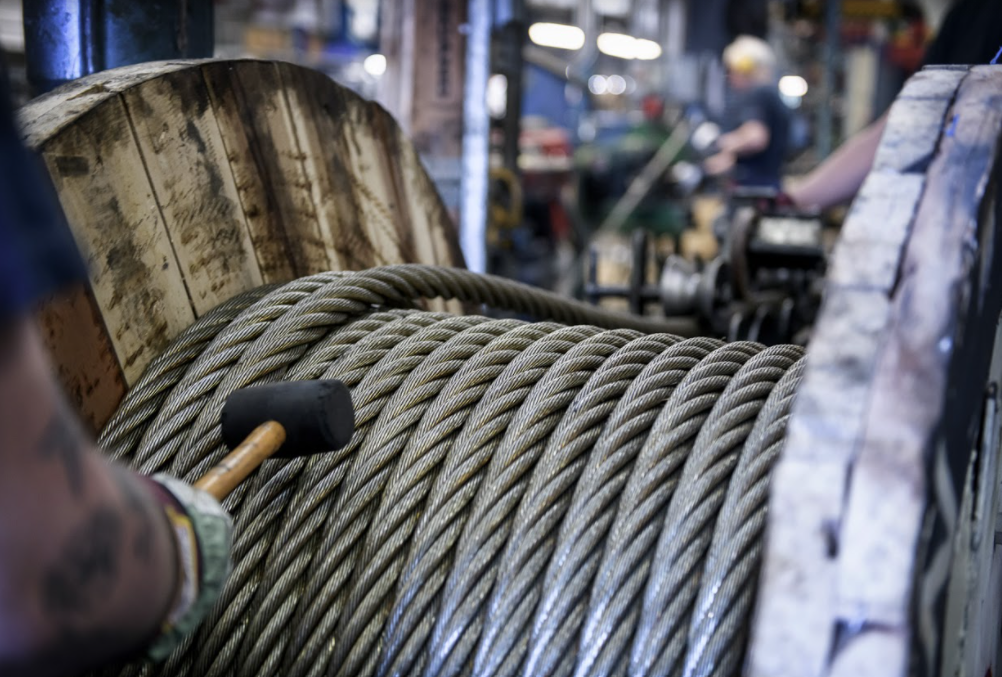Almost all steel wire ropes have a rope fitting. What types of wire rope fittings exist? And what should you pay attention to in your search for the right fitting? Discover more in this article.
A wire rope fitting is often combined with a hook, turnbuckle or shackle. The fitting that best suits the steel wire rope depends on the application. First, we make a distinction between permanent and non-permanent wire rope fittings.
Permanent wire rope fittings
A permanent wire rope fitting is inseparable from the steel wire rope.
Versions
Examples of permanent wire rope fittings are:
- Sockets (molded or pressed)
A properly molded socket is the strongest wire rope fitting and is 100% efficient. A molded socket is therefore widely used in situations where you want to realize the maximum breaking load of the steel wire rope. For example, this application is frequently used for breaking tests. We also often see the application of sockets at bridges and locks.
A pressed socket (also called terminal) is suitable for steel wire ropes with a diameter of up to 65 mm. In comparison with molded sockets, pressed sockets save a lot of weight. This is especially important for guy-wires. Think of mobile cranes and draglines.
- Clamps
The talurit clamp is often used to make a loop connection (with or without thimbles). When applied correctly, 90% of the minimum breaking load is retained.
- Thimbles
A thimble is found on the inside of the loop or the eye at the end of a wire rope. The (reinforced) thimble ensures that the steel wire rope does not kink under load. The thimble also prevents wear and keeps the eye of the wire rope open (make sure the thimble has the correct pin diameter).
Non-permanent wire rope fittings
Non-permanent wire rope fittings are connections you can loosen without damaging the steel wire rope. This makes them suitable for situations where you cannot determine the correct cable length. This is the case, for example, with spans.
Non-permanent wire rope fittings are also often preferred if the wire rope has to be disconnected regularly. This is the case with mobile cranes, for example.
Versions
Some of the many non-permanent rope fittings:
- Wedge socket or wig sockets
A wedge or wig socket is an end fastener that is suitable for situations where the fastener needs to be disconnected regularly. This is the case, for example, with blocks of mobile cranes or if you need to adjust the rope length in between.
Nowadays, mobile crane fittings are pressed or molded onto the cable, which is then fixed in a wedge or wig socket.
- Wire clamp or U-bolt
A wire clamp is used to provide both cable ends with a loop by clamping them against each other. This wire rope fitting is widely used for moving load horizontally. A wire clamp or U-bolt is unsuitable for lifting purposes.
- Eureka grip
Eureka grips are only suitable for standard 6- or 8-strand steel wire ropes. They are not suited for compacted and hammered steel wire ropes. The advantage of a Eureka grip is that it’s quick and easy to apply.
Loss factor: influence on the workload
In most cases, the wire rope fitting affects the maximum breaking load of the steel wire rope. Each wire rope fitting has a so-called loss factor. At 90% efficiency, this means the maximum workload should be reduced by 10% because of the fitting.
Get advice
In this article, we only mention a few of the many wire rope fittings that are possible. A wire rope fitting is often tailor-made. Please contact us for non-binding advice. Our experts have years of experience, and we offer a wide variety of special wire rope fittings.
Read more
Knowledge articles
Discover the main concerns of steel wire ropes:
- The history of steel wire rope
- The composition of steel wire ropes
- Breaking load, usage rate and workload
- How corrosion affects steel wire ropes

Services
Discover how Mennens can support you:




